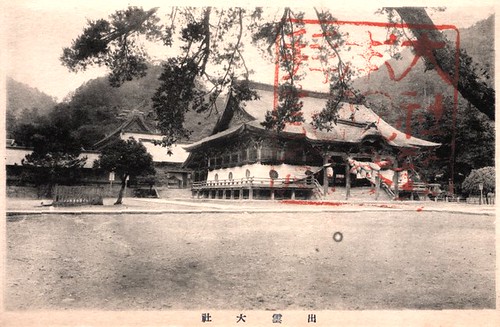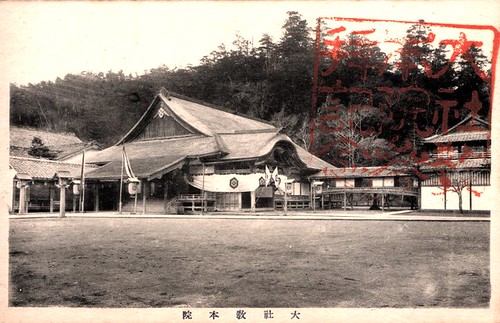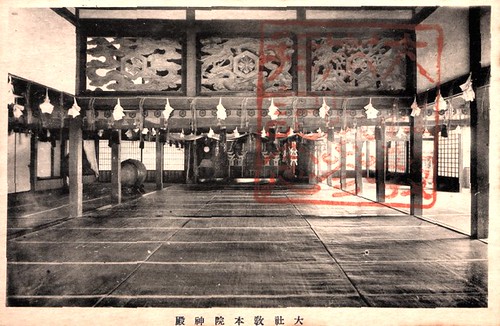Izumo
C. and I are back from the Dark Side of the Mountains, which we visited over the weekend. Here are some old postcards I bought up there, showing a roughly Taishō-period Izumo Shrine.
Here's something I didn't know about Izumo Ōyashiro (as they prefer to call it there): its administrators claim descent from the gods, just like the emperor. The story is that Ōkuninushi no Ōkami moved into the dangerous and disease-ridden mundane world, fixed it up, then handed it over to his aunt Amaterasu Ōmikami in an event fondly known as the kuni-yuzuri (nation-yielding).
This cleared the way for Amaterasu Ōmikami's grandson Ninigi no Mikoto to claim temporal Japan, while Ōkuninushi no Ōkami himself "retired" to a residence which Amaterasu Ōmikami had built for him out of gratitude. She also ordered her other son, Ame-no-Hohi no Mikoto, to serve him there (thus inventing the Shintō priesthood, as it happens).
And so, as Izumo Ōyashiro's English pamphlet puts it:
[That residence] is Izumo Grand Shrine, and it is from here that O-kuninushi-no-okami lovingly guides us all to happiness, and even now he is devoutly worshipped for this. The administrators of the rituals for O-kuninushi-no-okami and Izumo Oyashiro are descended in a single lineage from Amenohohi-no-mikoto, the original servant of the shrine.
(Note that Ame-no-Hohi no Mikoto was not Ninigi's father—that was Ame-no-Oshihomimi no Mikoto—which means that the latest common ancestor shared by the imperial line and the Izumo administrators is Amaterasu Ōmikami herself.)
![[No-sword]](http://no-sword.jp/images/site/no-sword_banner.jpg)






無名酒:
Of course, it wasn't always good family relations between the Kings of Izumo (and its shrine) and the Emperors in the Kinai. There's the story in Nihon shoki of how the sacred treasure left Izumo to be held in the capital (it involved fratricide); and according to the ritual codes, the Izumo Kings had to come and swear fealty to each new Emperor. (Not unlike the yearly "submission" of some groups from elsewhere in Japan--I'm not sure what made the 国栖 so exotic, but they had to come and present ethnic dances yearly. And those guys weren't from Kyushu or Tohoku even.)
I can't remember if the regional bigwig/shrine head who used to take up all the available maidens for "shrine attendants" and sleep with them was from Izumo, or some other regional shrine like Kashima. I'd have to check the Sandai kyaku for that.